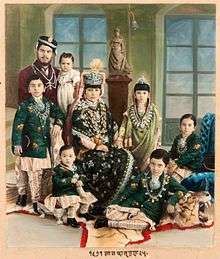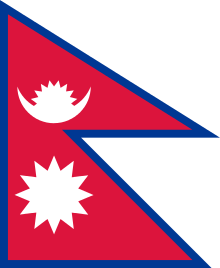Rana dynasty
| Rana dynasty | |
|---|---|
 | |
| Country | |
| Titles | |
| Founded | 1846 |
| Founder | Jung Bahadur Rana |
| Final ruler | Mohan Shamsher Jang Bahadur Rana |
| Deposition | 1951 (presently as pretender) |
| Religion | Hinduism |

Part of a series on the |
|---|
| History of Nepal |
 |
|
| Timeline |
|
|
Rana dynasty (Nepali: राणा वंश Rāņā bamsa) is a Khas Rajput (Chhetri) dynasty and were autocratic leaders[1] which ruled the Kingdom of Nepal from 1846 until 1951, reducing the Shah monarch to a figurehead and making Prime Minister and other government positions hereditary.[2][3] This changed in 1951 with the promulgation of a new constitution, when power shifted back to the monarchy of King Tribhuvan.[4] The dynasty is descended from Bal Narsingh Kunwar who was the son-in-law of Thapa Kaji Nain Singh Thapa of powerful Thapa dynasty.[5] The Kunwar family (now Rana dynasty) came to power being relatives powerful Mukhtiyar Bhimsen Thapa. The founder of this dynasty Jung Bahadur Rana murdered his own maternal uncle Prime Minister Mathabarsingh Thapa and consolidated power after Kot Parva (Kot massacre) and Bhandarkhal Parva.[6]
Rana Prime Ministers
Nine Rana rulers took the hereditary office(s) of Prime Minister, Supreme Commander-in-Chief and Grand Master of the Royal Orders. All were styled Maharaja of Lamjung and Kaski.
- Ratanjit Kunwar Rana (1723-1815)
- Bala Narsingh Kunwar Rana (1783-1841)
 I. Shrī Tīn Jung Bahadur Rana GCB, GCSI (18 June 1816 – 25 February 1877). Prime Minister and C-in-C 15 September 1846 to 1 August 1856 and from 28 June 1857 until his death. Granted the hereditary title of Rana on 5 May 1848, as a suffix to the male members of his family. Granted the hereditary title of Maharaja of Lamjung and Kaski (to be enjoyed ‘offspring to offspring’, and the hereditary offices of Prime Minister and C-in-C (to be enjoyed in succession by his surviving brothers, his sons, then his nephews), 6 August 1856. Received a salute of 19 guns from the British.
I. Shrī Tīn Jung Bahadur Rana GCB, GCSI (18 June 1816 – 25 February 1877). Prime Minister and C-in-C 15 September 1846 to 1 August 1856 and from 28 June 1857 until his death. Granted the hereditary title of Rana on 5 May 1848, as a suffix to the male members of his family. Granted the hereditary title of Maharaja of Lamjung and Kaski (to be enjoyed ‘offspring to offspring’, and the hereditary offices of Prime Minister and C-in-C (to be enjoyed in succession by his surviving brothers, his sons, then his nephews), 6 August 1856. Received a salute of 19 guns from the British.- Bam Bahadur Kanwar Rana (1818- 25 May 1857; Prime Minister: 1 August 1856 - 25 May 1857)
 II. Shrī Tīn Ranodip Singh (aka Ranodip Singh Rana) KCSI (3 April 1825 – assassinated 22 November 1885). Ruled 25 February 1877 to 22 November 1885.
II. Shrī Tīn Ranodip Singh (aka Ranodip Singh Rana) KCSI (3 April 1825 – assassinated 22 November 1885). Ruled 25 February 1877 to 22 November 1885.- General Sri Dhir Shumshere Jung Rana Bahadur (1828-1884)
 III. Shrī Tīn Bir Shumsher Jung Bahadur Rana GCSI (10 December 1852 – 5 March 1901). Ruled 22 November 1885 to 5 March 1901.
III. Shrī Tīn Bir Shumsher Jung Bahadur Rana GCSI (10 December 1852 – 5 March 1901). Ruled 22 November 1885 to 5 March 1901. IV .Shrī Tīn Dev Shumsher Jung Bahadur Rana (17 July 1862 – 20 February 1914). Ruled 5 March to 27 June 1901, when as a result of his progressive nature, he was deposed by his relatives and exiled to India.
IV .Shrī Tīn Dev Shumsher Jung Bahadur Rana (17 July 1862 – 20 February 1914). Ruled 5 March to 27 June 1901, when as a result of his progressive nature, he was deposed by his relatives and exiled to India. V. Shrī Tīn Chandra Shumsher Jung Bahadur Rana GCB, GCSI, GCMG, GCVO (8 July 1863 – 26 November 1929). Ruled 27 June 1901 to 26 November 1929.
V. Shrī Tīn Chandra Shumsher Jung Bahadur Rana GCB, GCSI, GCMG, GCVO (8 July 1863 – 26 November 1929). Ruled 27 June 1901 to 26 November 1929.
-
 IX. Shrī Tīn Mohan Shumsher Jung Bahadur Rana GCB, GCIE, GBE (23 December 1885 – 6 January 1967). Ruled 30 April 1948 to 18 February 1951, at which date he was divested of his titles and later went to India.
IX. Shrī Tīn Mohan Shumsher Jung Bahadur Rana GCB, GCIE, GBE (23 December 1885 – 6 January 1967). Ruled 30 April 1948 to 18 February 1951, at which date he was divested of his titles and later went to India.
-
 VI. Shrī Tīn Bhim Shumsher Jung Bahadur Rana GCSI, GCMG, KCVO (16 April 1865 – 1 September 1932). Ruled 26 November 1929 to 1 September 1932.
VI. Shrī Tīn Bhim Shumsher Jung Bahadur Rana GCSI, GCMG, KCVO (16 April 1865 – 1 September 1932). Ruled 26 November 1929 to 1 September 1932.
-
 VIII. Shrī Tīn Padma Shumsher Jung Bahadur Rana GCSI, GCIE, GBE, (5 December 1882 – 11 April 1961). Ruled 29 November 1945 to 30 April 1948, whereupon he abdicated in favor of his cousin.
VIII. Shrī Tīn Padma Shumsher Jung Bahadur Rana GCSI, GCIE, GBE, (5 December 1882 – 11 April 1961). Ruled 29 November 1945 to 30 April 1948, whereupon he abdicated in favor of his cousin.
-
-
 VII. Shrī Tīn Juddha Shumsher Jung Bahadur Rana GCB, GCSI, GCIE (19 April 1875 – 20 November 1952). Ruled 1 September 1932 to 29 November 1945, whereupon he abdicated in favor of his nephew.
VII. Shrī Tīn Juddha Shumsher Jung Bahadur Rana GCB, GCSI, GCIE (19 April 1875 – 20 November 1952). Ruled 1 September 1932 to 29 November 1945, whereupon he abdicated in favor of his nephew.
- Bala Narsingh Kunwar Rana (1783-1841)
Succession
Succession to the prime ministership and the title of Maharaja of Lamjung and Kaski was by agnatic seniority, by which the oldest male heir among the sons of equal (a-class) marriages in a generation would succeed. The order of succession was determined by seniority, with each eligible male heir holding a military command, as follows:
- Prime Minister and Commander-in-Chief (Mukhtiyar the Heir Apparent, with the rank of Field Marshal)
- Western Commanding-General.
- Eastern Commanding-General.
- Southern Commanding-General.
- Northern Commanding-General.
See also
- Daudaha system
- Pajani System
- Rolls of Succession in Rana (Nepal)
- History of Nepal
- Rana palaces of Nepal
- Thapa dynasty
References
- ↑ Greater Game: India's Race with Destiny and China by David Van Praagh
- ↑ Dietrich, Angela (1996). "Buddhist Monks and Rana Rulers: A History of Persecution". Buddhist Himalaya: A Journal of Nagarjuna Institute of Exact Methods. Retrieved 17 September 2013.
- ↑ Lal, C. K. (16 February 2001). "The Rana resonance". Nepali Times. Retrieved 17 September 2013.
- ↑ Kraemer, Karl-Heinz. "Democratization and political parties in Nepal". Harvard University. Retrieved 2012-11-25.
- ↑ JBR, PurushottamShamsher (1990). Shree Teen Haruko Tathya Britanta (in Nepali). Bhotahity, Kathmandu: Vidarthi Pustak Bhandar. ISBN 99933-39-91-1.
- ↑ Rana, Purushottam S.J.B. (1998). Jung Bahadur Rana: the story of his rise and glory. Book Faith India. p. 150. ISBN 81-7303-087-1.
External links and Sources
- Friend in need:1857, Friendship forgotten:1887 William Digby-Friend in need:1857, Friendship forgotten:1887
- Lambjang and Kaski - Brief History at Royalark.
- Old pictures of Nepal from Rana Dynasty
